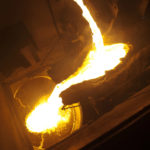Have you heard the term “decarburization”? Consider this.
According to Corrosionpedia:
Decarburization is the change in content and structure of steel wherein some surface layers of steel and carbon are lost. In complete decarburization, the top layer of steel consists mainly of ferrite materials, while partial decarburization presents a combination of materials. Microscopy is one of the techniques to determine carbon loss.
Corrosionpedia Explains Decarburization
Decarburization normally takes place when steel goes through the heating process in an environment where oxygen is present, resulting in loss of carbon and oxidation. This process takes place when carbon existing in metals reacts with gases containing hydrogen or oxygen during heating at 700°C.
Adverse effects of decarburization include:
- Reduced ductility
- Reduced strength
- Formation of cracks
- Formation of a scaly surface texture
Decarburization can be either dangerous or beneficial, depending on the way it is applied or how the metal is used. In some cases, decarburization may be induced deliberately. In other circumstances, it can be due to corrosion or poor handling.
When considered a defect, material testing can be useful to determine whether carbon loss levels are acceptable. If not, the steel or material will not be utilized for production. Carbon loss can result in unstable steel, which leads to reduced performance. This may also lead to various problems with machinery created from steel. In other settings where decarburization is deliberately performed, testing can be performed to identify the level of decarburization.
The rate of decarburization is controllable. If it is not intended, protective coatings are beneficial to prevent corrosion of the steel. Another measure is to have the steel heated in an inert environment which lacks oxygen.






